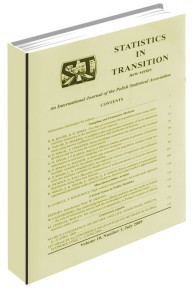ESTIMATING SENSITIVE POPULATION PROPORTION USING A COMBINATION OF BINOMIAL AND HYPERGEOMETRIC RANDOMIZED RESPONSES BY DIRECT AND INVERSE MECHANISM
ESTIMATING SENSITIVE POPULATION PROPORTION USING A COMBINATION OF BINOMIAL AND HYPERGEOMETRIC RANDOMIZED RESPONSES BY DIRECT AND INVERSE MECHANISM
Author(s): Kajal Dihidar, Manjima BhattacharyaSubject(s): Economy, National Economy, Public Finances, Socio-Economic Research
Published by: Główny Urząd Statystyczny
Summary/Abstract: For various reasons individuals in a sample survey may prefer not to confide to the interviewer the correct answers to certain potentially sensitive questions such as the illegal use of drugs, illegal earning, or incidence of acts of domestic violence, etc. In such cases the individuals may elect not to reply at all or to reply with incorrect answers. The resulting evasive answer bias is ordinarily difficult to assess. The use of a randomized response method for estimating the proportion of individuals possessing those sensitive attributes can potentially eliminate the bias. Following Chaudhuri and Dihidar (2014) and Dihidar (2016), here, as a possible variant, we have made an attempt to estimate the sensitive population proportion using a combination of binomial and hypergeometric randomized responses by direct and inverse mechanism. Along with the traditional simple random sampling, with and without replacement, we consider here sampling of respondents by unequal probabilities. Essential theoretical derivations for unbiased estimator, variance and variance es-timators are presented for several sampling schemes. A numerical illustration is performed to make a comparative study of the relative efficiencies of the direct and inverse mechanism.
Journal: Statistics in Transition. New Series
- Issue Year: 18/2017
- Issue No: 2
- Page Range: 4-21
- Page Count: 18
- Language: English

